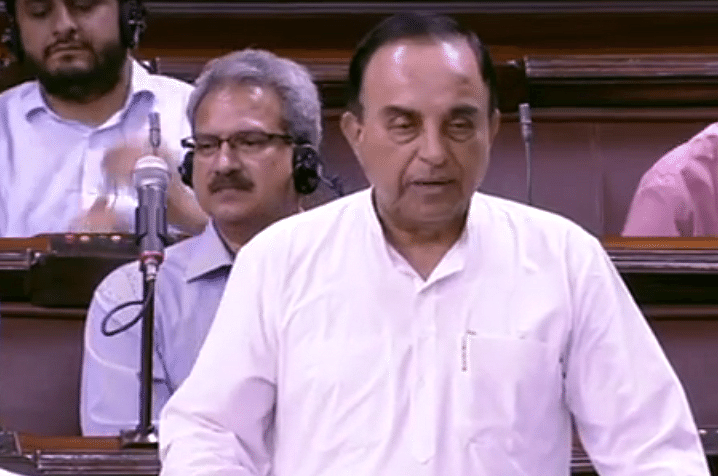Politics
Five Reasons Why The Swamy-Parrikar Speeches in The Rajya Sabha Were A Hit

Subramanian Swamy
Rajya Sabha TV (online) saw a 900% spike in viewership when “maverick” leader Subramanian Swamy got up to speak earlier this week on the AgustaWestland scam. In Bollywood parlance, one might call it a “seeti and taali” moment.
Manohar Parrikar’s quick follow-up speech was well lauded and is all over social media over the last 24 hours. Going back to Bollywood... almost a Jai-Veeru moment.
It didn’t help that the opposition parties seemed like deer in headlights. While some mumbled monotone responses, the others were too busy kicking self-goals (“My name only appears four times.”).
So anyway. What IS getting the public excited about the Rajya Sabha? Why are people dropping other engagements, to be mere spectators to a political debate? This, especially at a time when the relevance of the Upper House has been vociferously questioned by many? Some have even sounded the death knell calling the Rajya Sabha the “House for the Unelectable”.
So what changed in the AgustaWestland debates?
The average, middle-class Indian citizen; bored of political-pandering and (un)parliamentary-pandemonium; connected with five components of the Swamy-Parrikar speeches.
1. Drama
Everyone loves an underdog story. Especially if he is (a) your favourite underdog, and (b) was left out to dry; by the very people he fed (votes in the 2014 elections too).
Subramanian Swamy’s fan base is no secret. Twitter ranks him at number 2, just behind PM Modi. Every TV appearance of his is a TRP bonanza for news channels.
So when he got up to speak, it was quite a filmy moment for the fan base. Almost like a Bollywood hero, beaten black-and-blue by henchmen; who still stands up, wipes the blood of his brows to finally vanquish the villain.
Swamy played to the gallery well, with not-so-hidden references of “you know who”, and jibes at the usual suspects. The result, 70,000 YouTube views on Swamy’s speech compared to a paltry 1,700 on Ahmed Patel’s.
2. Facts
The May 4th debate was a diametrically-opposite experience to the fish-market proceedings where parliamentarians are out-shouting one another. This debate was about facts.
Facts were well presented by both sides. Citations, page numbers, section numbers, court rulings, the works. The narrative shifted from “I think” and “I feel”, to “Here’s what really happened”. Sure, there were conflicting views with the truth behind the chopper purchases. That’s part of the job description.
But there’s still no escaping the fact that fingers were pointed more towards documents, than towards each other.
3. NIGYSOB
Google it up if you don’t know what NIGYSOB is! In essence, NIGYSOB is the equivalent of “Ab aaya oonth pahaad ke neeche”; the overwhelming emotion that makes saas-bahu serials tick.
Indian citizens have taken corruption as par for the course; a bane that has crushed the collective optimism for decades. Corruption has taken on so much political weight lately, that mere lip-service could make you Chief Minister.
Given that social context, there’s huge appetite for seeing a “perpetrator” come to justice. The AgustaWestland debates were just that. Unfolding of a courtroom drama, in a proper three-act structure (Setup, Confrontation and Resolution); with the first two unfolding right before the nation’s eyes.
4. Brevity
Let’s face it; we are an audience that likes bullet-points. The catchier the bullet-point, the better.
Karl Rove’s (Senior Advisor and Deputy Chief of Staff during the George W. Bush administration) primary contribution to the Bush presidency was his ability to spin complex geo-political deliberations into easily-digestible nuggets. Take the case of “You’re either with us, or against us”; a fundamentally flawed, false-binary, which was lapped up by American media and citizens alike.
The “Birbal ka bamboo” analogy went down really well with a ‘soundbyte-wala’ audience. This analogy will outlast ‘page-this and para-that’ kind of references, in our collective memory.
5. Humour
Fair or not - Slapstick is staple. We Indians enjoy man-slipping-on-banana-peel kind of humour more than any other kind.
The AgustaWestland debate saw many tall opposition leaders slip on banana peels. Some from the ruling party as well (with references to Brijesh Mishra). More often than not, these were peels they had strewn on the road themselves.
When Abhishek ManuSinghvi questioned the legitimacy of initials; Ahmed Patel essentially agreed that AP was him. When Ahmed Patel spoke, Digvijay Singh could be seen yawning right beside him. When Swamy referred to the opposition leaders as “dash-dash and dash-dash” (to circumvent the comments from being expunged), the treasury benches giggled.
Masala for thought
In the end, it was family-friendly masala. A more cerebral drama than we’re used to in parliament, but drama nonetheless.
Hopefully Rajya Sabha will take the lead in having debates, of the calibre that it was originally created for. Hopefully it will re-invent itself... From the House of the Unelectable; to the House of the Unputdownable.
Support Swarajya's 50 Ground Reports Project & Sponsor A Story
Every general election Swarajya does a 50 ground reports project.
Aimed only at serious readers and those who appreciate the nuances of political undercurrents, the project provides a sense of India's electoral landscape. As you know, these reports are produced after considerable investment of travel, time and effort on the ground.
This time too we've kicked off the project in style and have covered over 30 constituencies already. If you're someone who appreciates such work and have enjoyed our coverage please consider sponsoring a ground report for just Rs 2999 to Rs 19,999 - it goes a long way in helping us produce more quality reportage.
You can also back this project by becoming a subscriber for as little as Rs 999 - so do click on this links and choose a plan that suits you and back us.
Click below to contribute.
Latest